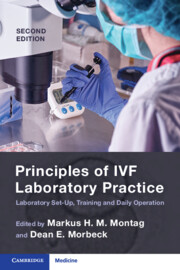Book contents
- Principles of IVF Laboratory Practice
- Principles of IVF Laboratory Practice
- Copyright page
- Contents
- Contributors
- Foreword
- The Evolution of IVF Practice
- Section 1 Starting a New Laboratory and Training Protocols
- Section 2 Pre-procedure Protocols
- Chapter 10 Mouse Embryo Assay for Quality Control in the IVF Laboratory
- Chapter 11 Sperm Survival Assay for Quality Control in the IVF Laboratory
- Chapter 12 Quality Control in the IVF Laboratory
- Chapter 13 Set-Up Procedures for Optimizing Performance in the IVF Laboratory
- Section 3 Gametes
- Section 4 Insemination/ICSI
- Section 5 Fertilization Assessment
- Section 6 Embryo Assessment: Morphology and Beyond
- Section 7 Embryo Cryopreservation
- Section 8 Embryo Transfer
- Section 9 Quality Management
- Index
- References
Chapter 12 - Quality Control in the IVF Laboratory
Continuous Improvement
from Section 2 - Pre-procedure Protocols
Published online by Cambridge University Press: 07 August 2023
- Principles of IVF Laboratory Practice
- Principles of IVF Laboratory Practice
- Copyright page
- Contents
- Contributors
- Foreword
- The Evolution of IVF Practice
- Section 1 Starting a New Laboratory and Training Protocols
- Section 2 Pre-procedure Protocols
- Chapter 10 Mouse Embryo Assay for Quality Control in the IVF Laboratory
- Chapter 11 Sperm Survival Assay for Quality Control in the IVF Laboratory
- Chapter 12 Quality Control in the IVF Laboratory
- Chapter 13 Set-Up Procedures for Optimizing Performance in the IVF Laboratory
- Section 3 Gametes
- Section 4 Insemination/ICSI
- Section 5 Fertilization Assessment
- Section 6 Embryo Assessment: Morphology and Beyond
- Section 7 Embryo Cryopreservation
- Section 8 Embryo Transfer
- Section 9 Quality Management
- Index
- References
Summary
The performance of the embryology laboratory is of imperative importance for the successful outcome of an assisted reproductive technology (ART) cycle. The development and viability of gametes and embryos can be compromised by small fluctuations in their environment, so it is crucial to establish optimal culture conditions at which gametes and embryos are attained and maintained. Having a robust control of culture conditions means that it is not necessary to search for a needle in a haystack when trouble-shooting. In order to ensure and maintain these very specific conditions, quality control (QC) routines need to be established with quality specifications for each quality parameter. These parameters are assessed on a daily, weekly, monthly or annual basis to determine whether they meet certain specifications, followed by any necessary fine-tuning to bring the levels back within the acceptable limits of uncertainty of measurement.
- Type
- Chapter
- Information
- Principles of IVF Laboratory PracticeLaboratory Set-Up, Training and Daily Operation, pp. 86 - 95Publisher: Cambridge University PressPrint publication year: 2023



